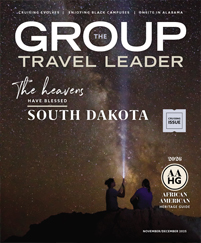Back when a map of America still showed large tracts of the unknown, settlers discovered the gorgeous panoramas of Elko, Nevada. With breathtaking mountains rivaling the Swiss Alps in size and beauty, Elko exemplifies the best of the Great American West.
With plenty of amenities in town, such as golf, event space and casinos, Elko also boasts easy access to wilderness. Group members can find themselves staring down at the world from atop the spectacular Ruby Mountains along the Lamoille Canyon Scenic Byway. For unspoiled views of lakes and mountains, groups can explore the popular South Fork State Recreation Area.
The town embraces its Wild West connection at the California Trail Historic Interpretive Center and the Western Folklife Center. Together, the museums illustrate life for the area’s settlers in the past and the present.
For an authentic look at the wide vistas and cowboy traditions of Nevada, groups will enjoy discovering Elko.
California Trail Historic Interpretive Center
If a gold rush happened today, people could plan all their travel details from their phones. People caught up in the California Gold Rush, however, sold their belongings, packed wagons and set out for California with no idea of the travails that lay ahead.
The California Trail Interpretive Center honors the pioneers of those who traveled and settled throughout California and Nevada in search of land and riches. Groups can learn about the 250,000 people who endured the 2,000-mile trek between 1841 and 1869.
The “Wagon Encampment” exhibit depicts a replica wagon commonplace along the California Trail. A traditional Shoshone village re-creates several shade houses made of willow and sage brush. Groups can learn about the trail and how it led to increased settlement in Elko.
“They have really tried to represent all of the area’s culture and history,” said Katie Neddenriep, executive director of the Elko Convention and Visitors Authority. “They tell the story of how mining impacted the area. They also present the evolution of the western Shoshone culture and heritage.”
Sculptures, murals, life-size dioramas and other multimedia exhibits explain the history. Groups can book a docent for themed tours or choose self-guided tours in the free museum.
Outside, groups can also walk part of the California trail with views of the Ruby Mountains.
The annual California Trail Days in late May or early June allows guests to immerse themselves in the history through musical performances, historic displays and special presentations.
Lamoille Canyon Scenic Byway
Instead of a desert ecosystem, the Ruby Mountains near Elko provide a verdant and lush landscape. Carved by the glaciers many millennia ago, the rugged peaks are decked in color with summer wildflowers and autumn leaves.
Groups can admire the Ruby Mountains at several overlooks along the Lamoille Canyon Scenic Byway. The 12-mile drive up the canyon follows the U-shaped Lamoille Canyon, sometimes called “the Grand Canyon of Nevada.” The route also provides views of Ruby Dome, the highest of the peaks, which rises 5,500 feet above the valley floor.
Interpretive signs along the route describe the geology of the canyon. To take in the granitelike peaks, green meadows and sapphire-blue lakes, groups can choose from several hiking trails. Hikers can often spot some of the area’s abundant wildlife, including mule deer, mountain goats, bighorn sheep and a variety of bird species.
“Friends of the Ruby Mountains offers demonstrations and wildlife talks,” said Neddenriep. “There are also local guides that can lead horseback experiences for groups in the Lamoille Canyon. There is even a family that runs a heli-skiing operation.”
Groups can also opt for rock climbing, cross-country skiing, snowmobiling, mountain biking and fishing excursions. The upper portion of the road is sometimes closed during the winter months because of snow, though skiing in other areas remains popular.
Western Folklife Center
Cowboys spend a lot of time sitting on horses and contemplating the beauty of the West. Inspiration sometimes strikes during these reflective moments, and it can be shared with the public at the National Cowboy Poetry Gathering each January.
Held at the Western Folklife Center, the winter event showcases contemporary cowboy craftsmanship, Native American art and hands-on demonstrations. Groups can attend demonstrations on gear-making, cooking, dancing and writing. Live poetry, music and talks also feature Western ranchers and cowboy works.
The Western Folklife Center keeps the artistic tradition alive year-round with an exhibition gallery, a 300-seat theater, a 20-seat black-box theater, a historic saloon and a gift shop.
“The Western Folklife Center has demonstrations throughout the year that stem from the cowboy poetry gathering, like rawhide braiding,” said Neddenriep. “Groups can come to listen to cowboy poetry and learn about the importance of poetry. They can also watch musical performances or take a dance class.”
Permanent and rotating exhibits display some of the art originally debuted at the National Cowboy Poetry Gallery. Groups can also watch a 16-minute film adaptation of “Why the Cowboy Sings.”
South Fork State Recreation Area
Juniper-filled woodlands, meadows dotted with sagebrush clusters and rolling hills make the South Fork State Recreation Area an ideal habitat for wildlife. The almost 4,000-acre recreation area’s 1,650-acre reservoir also adds to the fun for visitors.
“The park can arrange special presentations for groups,” said Neddenriep. “Other organizations offer activities that can be coordinated. People love to go boating, fishing, paddleboarding, jet skiing and ice fishing in the wintertime.”
Lured by the consistent supply of water from the Upper Humboldt River, pioneers settled in the area in 1867. The South Fork Valley remains rich with vegetation and the water level even more consistent since the creation of a dam in 1988.
Trophy-size trout, catfish and bass swim in the reservoir, attracting anglers both experienced and novice. Other visitors float in tubes, kayaks, canoes and other boats.
Wildlife viewing is another favorite pastime. Mule deer, badgers, beavers and waterfowl regularly appear throughout the park.
The park sits 18 miles south of Elko, with the Ruby Mountains visible in the background.
Those seeking a foray into the wilderness can explore the Wild Horse State Recreation Area. Situated 66 miles north of Elko, the park contains another giant reservoir at 2,830 acres. Elk, pronghorn deer and upland game birds live in the recreation area.











